Individual's pages
This area provides a place where individuals can post their EPD-related studies. See the "child pages" below.Cosmic tests at BNL
Cosmic tests at BNL - strange results (Dec. 7, 2017)All of the relevant plots, only a few of which are shown in this blog as examples, can be found here: https://drupal.star.bnl.gov/STAR/blog/adams92/te-chuan-huangs-plots-cosmic-tests-bnl
So far, here at BNL, we have taken 7 full cosmic runs. The cosmic runs use 4 large (~0.1 m wide by ~1 m long) paddles and tests 3 supersectors. One pair of paddles sits above the supersectors and another pair sits below. They can only cover half of a supersector, so we do a run with the odds covered and then do a separate run with the evens covered. The paddles can be used to determine the position and incident angle of each cosmic ray; however, we have been using the supersectors as offline triggers to isolate vertical cosmic rays (as was done at OSU). Some more detail is given in my presentation from this week's EPD meeting: https://drupal.star.bnl.gov/STAR/system/files/Cosmic%20Ray%20Testing%20at%20BNL.pdf
We realized earlier today that two of the 7 cosmic runs have strange results. These two runs were with (in one configuration) supersectors 21, 29, and 30 and (in another configuration) supersectors 23, 25, and 27. The strange results are:
1.1) The "zero" channels, which are non-existent supersector tiles, show what seems to be MIP peaks. There should of course be nothing.
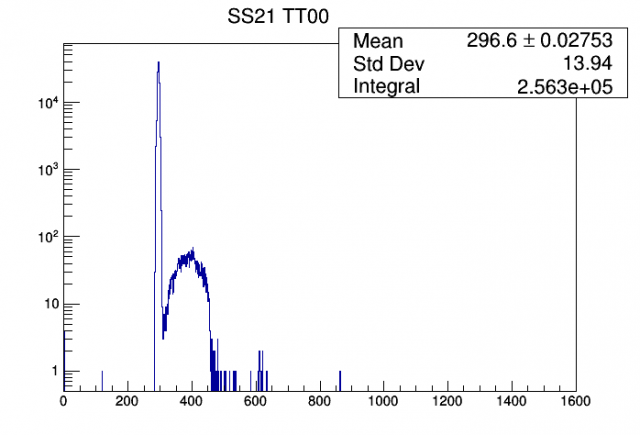 SS21_TT00:  
SS21_TT00:  For all 6 supersectors in the aforementioned "problem" runs, the tile 0 ADC distributions look like this.
1.2) For the configuration with supersectors 02, 03, and 04, the tile 0 ADCs also show what seem to be a very small MIP peak.
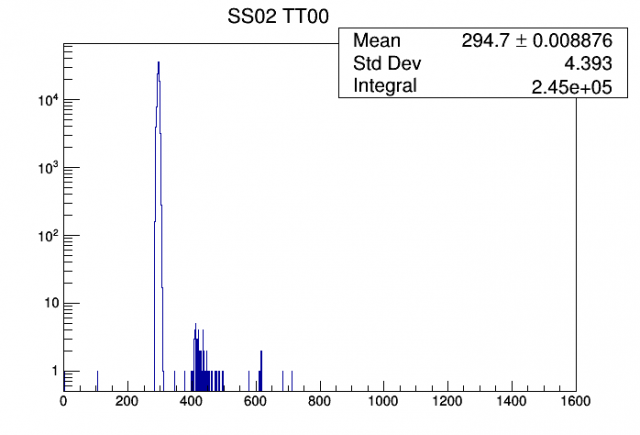 SS02_TT00:  
SS02_TT00:  For all 3 supersectors, this is seen in tile 0. In fact, this configuration (even tiles of supersectors 02, 03, and 04) was taken twice, and each 24-hour run shows this behavior in all 3 supersectors.
2.1) The ADC distributions do not represent standard MIP peaks. There is a bump to the right of the peak.
 SS21_TT16:  
SS21_TT16:  You guessed it: this is seen for all even tiles of supersectors 21, 23, 25, 27, 29, and 30. Supersectors 02, 03, and 04, which had the very small tile 0 signals, do not show this bump.
2.1)
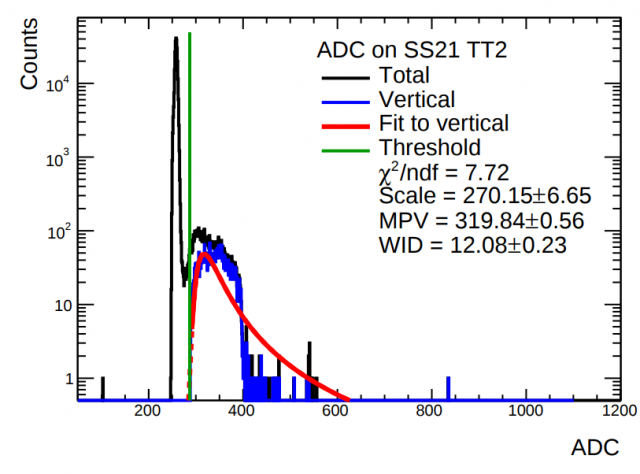 SS21_TT02_vertical:  
SS21_TT02_vertical:  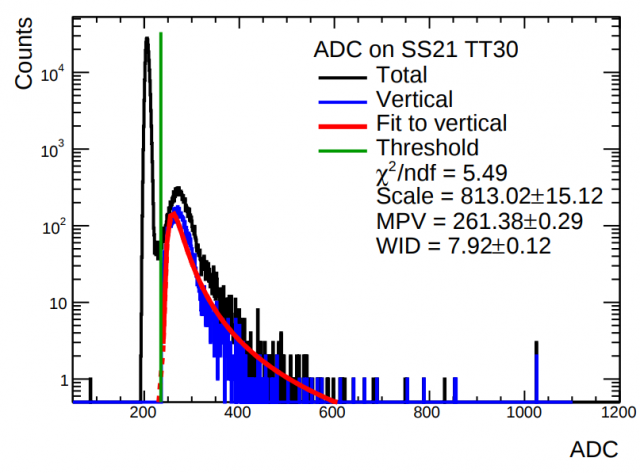 SS21_TT30_vertical:  
SS21_TT30_vertical:  At this point, I feel like I don't have to say that this behavior is true of supersectors 21, 23, 25, 27, 29, and 30.
Some notes:
1) The same fiber bundles are being used for all runs.
2) The same ADC channels, receiver cards, and trigger paddles are being used for the even and the odds.
3) Vertical cosmics are determined offline from the supersectors by requiring hits above some threshold in the same tile number of each supersector.
4) At OSU, we saw some random spikes and drops in the ADCs that were generally short lived but significant in magnitude. Here, they have been pretty stable.
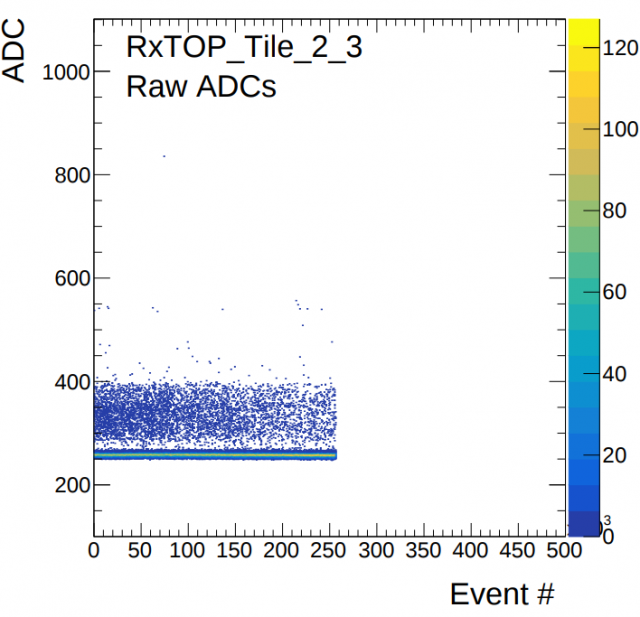 SS21_TT02_strip:  
SS21_TT02_strip:  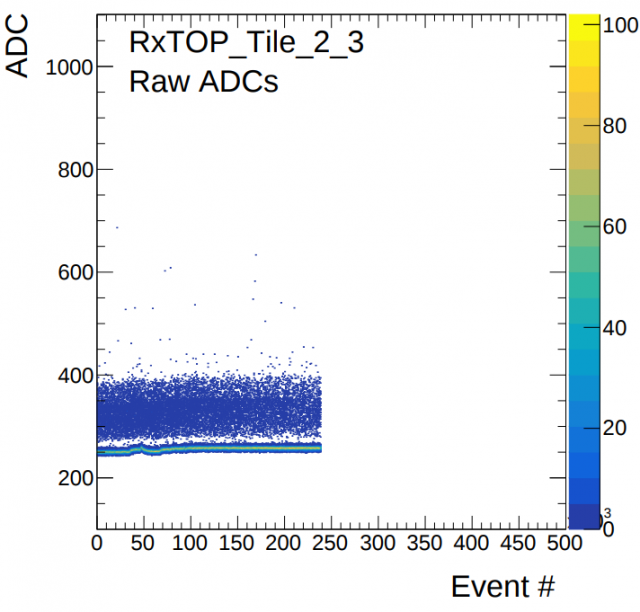 SS25_TT02_strip:  
SS25_TT02_strip:  5) At OSU, when performing the heat map tests at high bias voltage (~66 V), we saw the dark current walk in each tile independently.
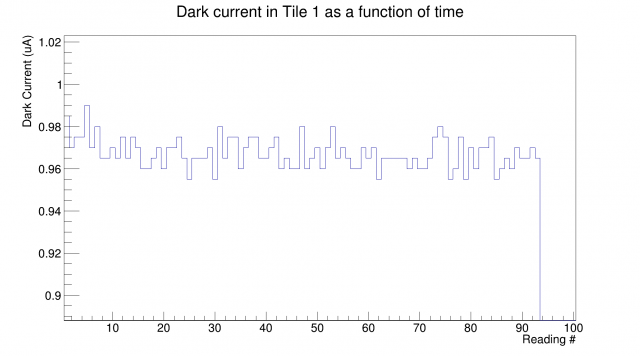 DarkWalk_TT01:  
DarkWalk_TT01:  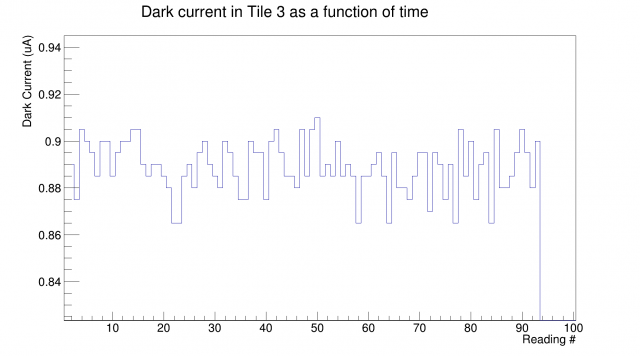 DarkWalk_TT03:  
DarkWalk_TT03:  A profile histogram showing all odd tile dark currents walking on average:
 DarkWalk_FEE5:  
DarkWalk_FEE5:  6) (Dec. 8th) Tim Camarda and I looked inside the FEE box to make sure everything was connected properly. We found nothing apparently wrong with the setup and proceeded to switch the FSCs in FEEs 5 and 6 (as well as their corresponding RX cables in the back of the corresponding RX card) to read the even tiles out of an "odd" FEE (i.e. a FEE previously used to measure only odd tiles). We didn't take enough data to see something wrong with the ADC distributions, but we DID see a non-pedestal signal in tile 0. I can't imagine there is anything physically creating a signal (let's just take that probability to be 0), so this implies that whatever problem we are seeing exists in ALL FEE cards and only happened to show up during the even runs.
7) The transmission of the fiber bundles we are using here at BNL are:
FB 10: -62%
FB 11: -62%
FB 17: -63%
The transmissions of the fiber bundles used at OSU are:
FB 02: -55%
FB 03: -54%
FB 04: -63%
FB 05: -62%
8) (Dec. 11th) It was realized in this week's EPD meeting that events with more than a few tiles firing were not thrown out; this cut was being applied for the cosmic testing at OSU. Te-Chuan Huang plotted the ADC_{Tile 0} vs the ADC_{Tile X}, and we see three main features: a pedestal (which is all that we should get in theory), a diagonal line (which likely is the shoulder we see in the "big" problem even tiles), and some fuzz in-between.
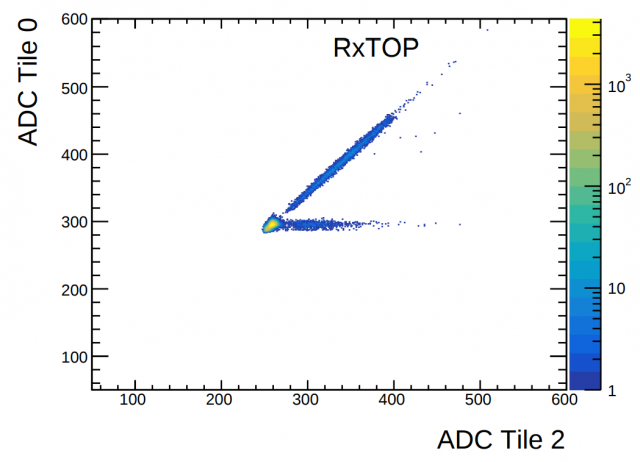 TOP_SS212930:  
TOP_SS212930:   MID_SS212930:  
MID_SS212930:  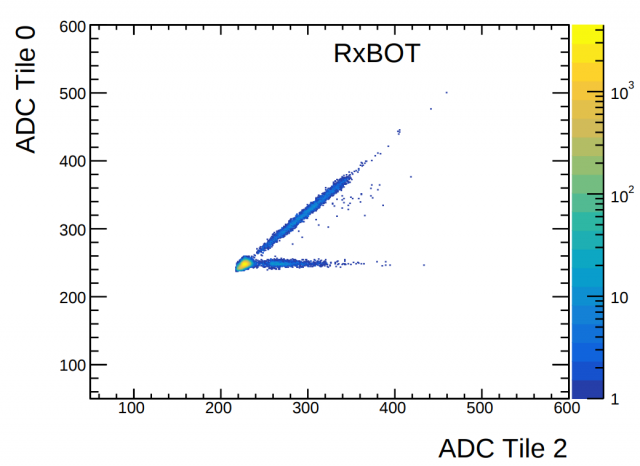 BOT_SS212930:  
BOT_SS212930:  This is plotted against ADC_{Tile 2}, but the same behavior exists for all tiles. The slopes are not the same in every case, but the slope associated with RxMID is consistently lower than the slopes of RxTOP and RxBOT. The diagonal is likely associated with all channels firing at once.
For the "small" problem runs, we see the same features: a pedestal, a diagonal, and some fuzz in-between. The difference is that there are fewer "diagonal" or "fuzz in-between" events in these runs.
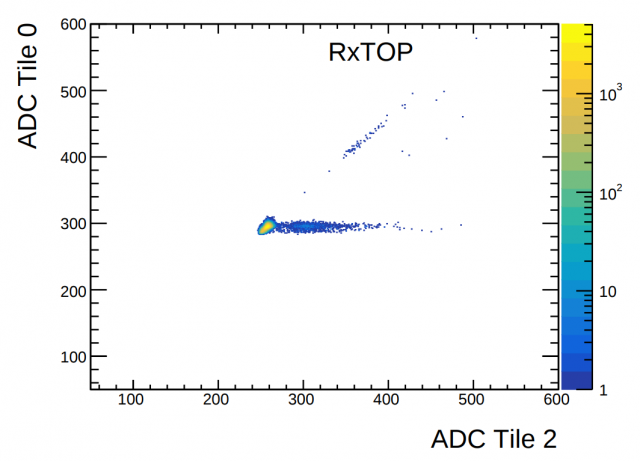 TOP_SS020304:  
TOP_SS020304:  It seems likely that the "small" and "big" problems are really the same, time-varying problem; that this problem just so happened not to be present during the odd runs, to be more dominant during the first two even runs, and not to be as dominant during the following even runs.
8) (Dec. 12th) In order to rule out cross talk at the FSC, I produced a cross-talk heat map including tile 0. The "Excess Current With Source [underneath]" obviously doesn't make sense for tile 0, so I took it to be 0.1 uA (other tiles typically have an excess of 0.5 uA) to make the colors more discernible.
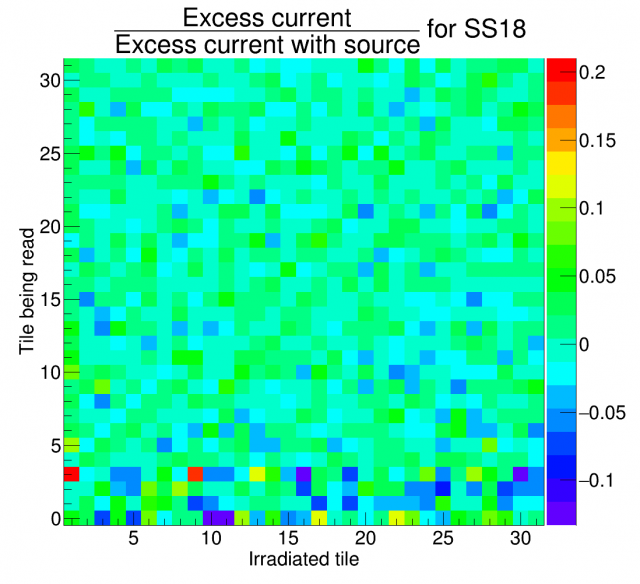 FSC_xTalk:  
FSC_xTalk:  We see from the bottom row (the only relevant part of the plot) that there is just noise. If the FSC cross talk was existent, we would see it between tile 0 and tiles 1, 2, 8, 9, and 10; we don't see that here.
9) (Dec. 12th) In order to see whether the problem is isoloated to a given FEE/Rx card or if it is global, ADC_{tile 0, RxTOP} was plotted against ADC_{tile X, RxMID} and ADC_{tile X, RxBOT}.
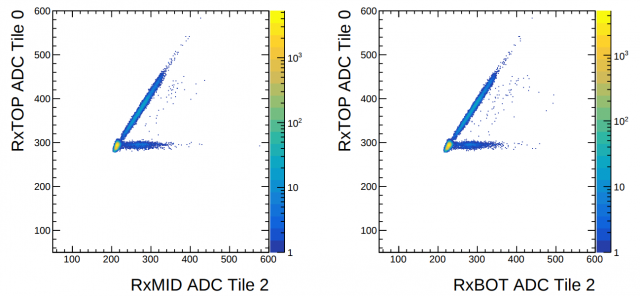 TOP0vsMIDandBOT:  
TOP0vsMIDandBOT:  There are no noticeable differences between these plots and those within the same Rx card (see point 8), indicating that this is a global problem
10) (Dec. 12th) In an attempt to remove the diagonal and "fuzz" addressed in point 8, a cut was applied to throw away events with more than 10 tiles in a given supersector reading hits. This removed most of the diagonal and fuzz.
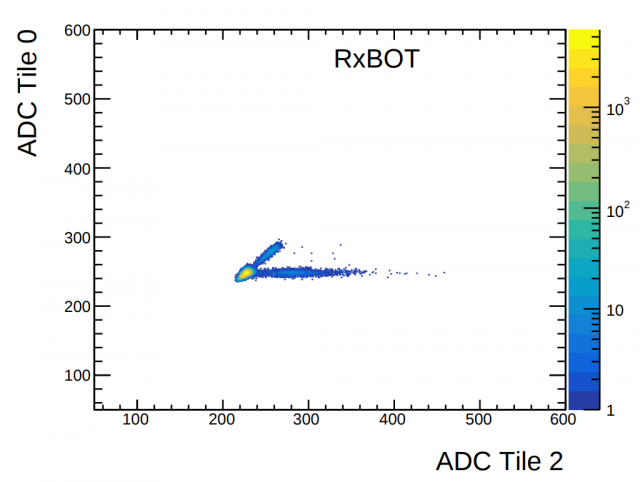 ADC_10hitCut:  
ADC_10hitCut:  There is a soft cutoff in ADC_{tile 0} for each plot.
11) (Dec. 12th) Just to make sure that this problem is not isolated to tile 0, ADC_{tile 10} was plotted against ADC_{tile X} with the cut mentioned in point 9.
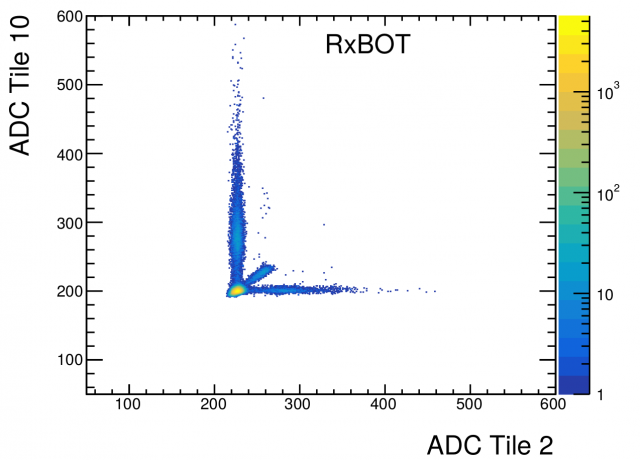 ADC_tile10vsTileX:  
ADC_tile10vsTileX:  Unsurprisingly, we see that this problem is not isolated to tile 0.
___________________________________________________________________________________________________________________________________________________________________________________________
Isaac Upsal
Generally stuff is on my blog (https://drupal.star.bnl.gov/STAR/blog/iupsal), so I'll provide links to EPD stuff here.Maybe useful references:
pEPD darkcurrent measurements showing radiation damage:
https://drupal.star.bnl.gov/STAR/blog/iupsal/sipm-dark-current-2015-pepd
EPD cosmic tests (from Joey):
https://drupal.star.bnl.gov/STAR/blog/iupsal/osu-epd-supersector-cosmic-tests
EPD v2 at 54GeV:
https://drupal.star.bnl.gov/STAR/blog/iupsal/first-look-epd-v2
EPD centrality NN study for 54GeV data:
https://drupal.star.bnl.gov/STAR/blog/iupsal/epd-centrality-nn-study
BBC tile size crosscheck (the BBC page is wrong)
https://drupal.star.bnl.gov/STAR/blog/iupsal/bbc-tile-size
Probably not interesting in the future:
GEANT stuff:
https://drupal.star.bnl.gov/STAR/blog/iupsal/epd-geant-simulation-update
pEPD cosmic testing ect.:
https://drupal.star.bnl.gov/STAR/blog/iupsal/osu-epd-testbench-bes-meeting-feb23-2015
https://drupal.star.bnl.gov/STAR/blog/iupsal/osu-epd-testbench-page-numbers
https://drupal.star.bnl.gov/STAR/blog/iupsal/osu-epd-testbench-epd-meeting-feb25-2015
https://drupal.star.bnl.gov/STAR/blog/iupsal/osu-epd-testbench-bes-meeting-march9-2015
https://drupal.star.bnl.gov/STAR/blog/iupsal/osu-epd-testbench-epd-meeting-march11-2015
pEPD FEE box geometry and cabling:
https://drupal.star.bnl.gov/STAR/blog/iupsal/pepd-2016-fee-box-geometry-and-cabling
OSU fiber polishing (Joey and Keith):
https://drupal.star.bnl.gov/STAR/blog/iupsal/osu-fiber-polishing-epd
EPD FEE box basics design and schematic (design in these documents is not final):
https://drupal.star.bnl.gov/STAR/blog/iupsal/epd-box-design
https://drupal.star.bnl.gov/STAR/blog/iupsal/epd-fee-box-schematic
Presentations given outside of EPD meetings:
October 2014 Upgrade workshop (this is all Alex, not me. I just thought it should be uploaded somewhere since I don't see it on the meeting page):
(attached)
November 2014 collaboration meeting:
https://drupal.star.bnl.gov/STAR/meetings/star-collaboration-meeting-november-3-7/plenary-session-i/epd
June 2015 Collaboration meeting (shared with Michael Lomnitz):
https://drupal.star.bnl.gov/STAR/content/epd-status
November 2017 Analysis meeting, Yang and I talk about 54GeV flow using the EPD during the BulkCorr meeting:
https://drupal.star.bnl.gov/STAR/meetings/star-fall-2017-analysis-meeting/bulk-correlations-parallel-2/epd-54-gev
February 2018 Collaboration meeting, I use a bit of my BulkCorr spot to talk about centrality (this is less detailed than the EPD meeting presentation):
https://drupal.star.bnl.gov/STAR/meetings/star-collaboration-meeting/bulkcorr/mag-field-r17
Justin Ewigleben
Justin Ewigleben's studies
Prashanth
Prashanth pagesRobert Pak
Robert Pak's studiesRosi Reed
Saehanseul Oh
Saehanseul Oh
Sam Heppelmann
Sam Heppelmann pagesTe-Chuan Huang
First results of autumn 2017 cosmic tests at STAR
The first vertical cosmics results:
- Landau fits: STAR/system/files/userfiles/3886/ADC_SS252723_odd.pdf
- presentation: drupal.star.bnl.gov/STAR/system/files/TeChuan_EPD_cosmic_20171204_0.pdf
Vertical cosmic rays of EPD with SS08181007 configurations
-
- FEE strips:
https://drupal.star.bnl.gov/STAR/system/files/SS08181007odd_Configuration1_Strips_FEE.pdf
https://drupal.star.bnl.gov/STAR/system/files/SS08181007odd_Configuration2_Strips_FEE.pdf
https://drupal.star.bnl.gov/STAR/system/files/SS08181007odd_Configuration3_Strips_FEE.pdf
https://drupal.star.bnl.gov/STAR/system/files/SS08181007odd_Configuration4_Strips_FEE.pdf
https://drupal.star.bnl.gov/STAR/system/files/SS08181007even_Configuration1_Strips_FEE.pdf
https://drupal.star.bnl.gov/STAR/system/files/SS08181007even_Configuration2_Strips_FEE.pdf
https://drupal.star.bnl.gov/STAR/system/files/SS08181007even_Configuration3_Strips_FEE.pdf
-
https://drupal.star.bnl.gov/STAR/system/files/TeChuan_EPD_cosmic_20170918_3.pdf
- ADC fits
https://drupal.star.bnl.gov/STAR/system/files/ADC_2.pdf
Vertical cosmic rays of EPD with SS14081516 and SS17181920 configurations
SS14081516 configuration:
Strips:
https://drupal.star.bnl.gov/STAR/system/files/SS14081516odd_Configuration1_Strips_FEE.pdf
https://drupal.star.bnl.gov/STAR/system/files/SS14081516odd_Configuration2_Strips_FEE.pdf
https://drupal.star.bnl.gov/STAR/system/files/SS14081516odd_Configuration3_Strips_FEE.pdf
https://drupal.star.bnl.gov/STAR/system/files/SS14081516even_Configuration1_Strips_FEE.pdf
https://drupal.star.bnl.gov/STAR/system/files/SS14081516even_Configuration2_Strips_FEE.pdf
https://drupal.star.bnl.gov/STAR/system/files/SS14081516even_Configuration3_Strips_FEE.pdf
ADCs:
https://drupal.star.bnl.gov/STAR/system/files/ADC_SS14081516.pdf
====================================================================================================
SS17181920 configuration:
Strips:
https://drupal.star.bnl.gov/STAR/system/files/SS17181920even_Configuration1_Strips_FEE.pdf
https://drupal.star.bnl.gov/STAR/system/files/SS17181920even_Configuration2_Strips_FEE.pdf
https://drupal.star.bnl.gov/STAR/system/files/SS17181920even_Configuration3_Strips_FEE.pdf
https://drupal.star.bnl.gov/STAR/system/files/SS17181920odd_Configuration1_Strips_FEE.pdf
https://drupal.star.bnl.gov/STAR/system/files/SS17181920odd_Configuration2_Strips_FEE.pdf
ADCs:
https://drupal.star.bnl.gov/STAR/system/files/ADC_SS17181920.pdf
presentation:
https://drupal.star.bnl.gov/STAR/system/files/TeChuan_EPD_cosmic_20170925_0.pdf
dummy
Xinyue Ju
Jinyue Ju from USTC